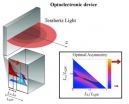(Press-News.org) While more and more genomic information is becoming available at a drastically increasing pace, the knowledge we can gain about how microorganisms interact with their surrounding, infect hosts and alter their molecular programs in accordance to changing environmental conditions remains widely not deducible from genomic data alone, the researchers from University of Southern Denmark claim. This raises questions regarding the value of newly sequenced species.
The researchers have analyzed the genomes that are available from the past 20 years of sequencing bacterial DNA. They tried to use this data pile to answer a simple questions: Can one distinguish between pathogenic and non-pathogenic bacteria based on their DNA content only?
No valuable knowledge about dangerous bacteria
When they found out that this is not possible in several cases, i.e. you cannot use these data to make such a simple but extremely important distinction, why should we bother collecting even more of this kind of data, the University of Southern Denmark scientists, Associate Professor Jan Baumbach and his doctoral student Eudes Barbosa from the Department of Mathematics and Computer Science at the University of Southern Denmark, now ask in a new study.
Almost 3,000 bacterial species have been sequenced so far. Another 24,000 sequencing projects are presently under way, and there are numerous additional projects on sequencing many more organisms from all kingdoms of life.
"One may ask for the value of all this", the researchers say.
Their research results now show that when it comes to bacteria science cannot count on getting useful information on their pathogenicity from DNA sequencing.
"Should we continue to sequence the DNA of bacteria on such a large scale? Maybe some of the effort and resources could be spent better", say Baumbach and Barbosa.
Proteins provide more valuable knowledge than DNA
Together with colleagues from the Max Planck Institute for Informatics in Germany and the Bioinformatics Department at the Federal University of Minas Gerais in Brazil, the two researchers performed in-depth investigations of 240 whole-genome DNA sequences from actinobacteria, one of the oldest clades on earth. It covers species of high medical relevance, such as Corynebacterium diptheriae (causing diphtheria), Mycobacterium tuberculosis (tuberculosis) and Mycobacterium leprae (leprae). In average, their genomes have around three million base pairs and five thousand genes.
Since the first sequenced genome of the influenza virus in 1995, researchers have deciphered several thousand of species and ca. 50 million genes. In total, we know about ten thousand bacterial species and bacteria-like archaea, but it is estimated that there are many more. Conservative bids suggests well above 100 million.
The University of Southern Denmark researchers emphasize that they are not generally opposed to DNA sequencing as a scientific tool at all. One should just be aware of its limited value regarding important follow-up questions, such as pathogenicity, virulence and infectiousness.
"We drown in data but starve for knowledge", Jan Baumbach says and continues:
"Modern sequencing technologies, so-called next-generation sequencers, are also used to study gene expression – by sequencing so-called mRNA."
This allows for measuring the activity of the genes under a specific condition (after infection, for instance) rather than their mere occurrence, which turns out to be uninformative, at least for bacterial infectivity.
"Such data can be expected to carry more information than the DNA sequence alone, and it can be used to illuminate the interplay of genes, as they do not act in isolation but in an orchestra," the bioinformatics group leader explains.
The important aspects of disease-causing bacteria are found in the genes activity, not in their DNA sequence.
"It's like a plane crash. The color of the plane does not matter. What matters is unraveling the parallel sequence of activities that lead to the accident." says Eudes Barbosa.
INFORMATION:
Ref: Briefings in Functional Genomics: On the limits of computational functional genomics of bacterial lifestyle prediction.
Photo of Jan Baumbach: Ricky Molloy/University of Southern Denmark. High res photos of Jan Baumbach can be downloaded here http://www.sdu.dk/en/Forskning/Forskningsformidling/ESOF/Forskere/Jan-Baumbach
Meet Jan Baumbach at ESOF2014 Science In The City Festival in Copenhagen June 21 – 26. Here Jan Baumbach will demonstrate a machine that is capable of analysing molecules in human breath and reveal details about our health. More info here http://www.sdu.dk/en/Forskning/Forskningsformidling/ESOF/Forskere/Jan-Baumbach
Contact Associate Professor Jan Baumbach. jbaumbac@imada.sdu.dk. Mobile: +45 51701281.
Scientists about sequencing data: We drown in data but thirst for knowledge
2014-06-18
ELSE PRESS RELEASES FROM THIS DATE:
Horizontal levitation: The ultimate solution to particle separation
2014-06-18
Magnetic separators exploit the difference in magnetic properties between minerals, for example when separating magnetite from quartz. But this exercise becomes considerably more complex when the particles are not magnetic. In the wake of previous particle levitation experiments under high-power magnetic fields, a new study reveals that particles are deflected away from the magnet's round-shaped bore centre in a horizontal direction. Previous studies had observed the vertical levitation of the particles. These findings are presented by Shixiao Liu from the Faculty of Engineering, ...
New quantum mechanism to trigger the emission of tunable light at terahertz frequencies
2014-06-18
Scientists have found that two-dimensional (2D) nanostructures with asymmetric design enable a new quantum mechanism, triggering the emission of tunable light at terahertz frequencies—with unprecedented efficiency.
The researchers, from the University of Southampton and Imperial College London, found that quantum wells, 2D nanostructures formed of several layers of semi-conductor alloys placed on top of each other like a sandwich, can enhance light emission in a technological challenging spectral range.
It is hoped that the findings will have an impact on photonic ...
Only 16 percent of Ph.D.s work in the private sector in Spain, half the OECD average
2014-06-18
This news release is available in Spanish.
The report explains that Ph.D.s who work as researchers represent, on average in the OECD, 68.6% of those who are employed. By institutional sectors, the percentages of employees who work as researchers break down as follows: 45.4% in the private sector, 70.8% in public administration and 75.9% in higher education. In Spain, 86% of Ph.D.s employed in higher education are researchers, while for the private sector, this figure is only 26.5%.
According to OECD figures, leading innovative countries like the United States, ...
A noisy world: Crabs can hear
2014-06-18
In new research published in the journal Proceedings of the Royal Society B, Northeastern University professor Randall Hughes and her team at the Marine Science Center in Nahant, Mass. are the first to show that sound plays at least as much of a role in mud crabs' reaction to fish behavior as other widely studied cues—and possibly more.
Fish are not silent creatures. Just like the terrestrial world, there's a veritable symphony of sound echoing under the sea. Indeed, the black drum fish was the subject of many a phone call to the Miami police back in 2005, when their ...
Want to know about vaping? Turn on the TV or go online
2014-06-18
Adults are widely exposed to e-cigarette marketing through the media, but those messages reach different demographic groups in different ways, according to a survey by researchers at the University of Illinois at Chicago's Institute for Health Research and Policy.
The study is published as a special supplement in the July 2014 issue of Tobacco Control.
Eighty-six percent of those surveyed were aware of e-cigarettes, and 47 percent had seen or heard about them on television, on the radio, in print media or online. The survey of 17,522 adults was conducted online last ...
Electrical switch during labour could be faulty in overweight women
2014-06-18
Crucially, the discovery, published today in the journal Nature Communications, shows that women who are overweight have a faulty switch. The finding may explain why overweight women have a higher likelihood of irregular contractions and are more likely to require a caesarean section than other women.
It's well known that strong rhythmic contractions of the uterus are needed to allow the baby's head to dilate the cervix. However little was known about what controls these contractions until now.
The groundbreaking research from Monash University, the Royal Women's Hospital ...
Stanford breakthrough provides picture of underground water
2014-06-18
Superman isn't the only one who can see through solid surfaces. In a development that could revolutionize the management of precious groundwater around the world, Stanford researchers have pioneered the use of satellites to accurately measure levels of water stored hundreds of feet below ground. Their findings were published recently in Water Resources Research.
Groundwater provides 25 to 40 percent of all drinking water worldwide, and is the primary source of freshwater in many arid countries, according to the National Groundwater Association. About 60 percent of all ...
A call to better protect Antarctica
2014-06-18
With visitor numbers surging, Antarctica's ice-free land needs better protection from human activities, leading environmental scientists say.
The new study, published today in the journal PLoS Biology, found that all 55 areas designated for protection lie close to sites of human activity. Seven are at high risk for biological invasions, and five of the distinct ice-free eco regions have no protected areas.
Antarctica has over 40,000 visitors a year, and more and more research facilities are being built in the continent's tiny ice-free area. Most of the Antarctic wildlife ...
Low cortisol levels may increase risk of depression in bipolar disorder
2014-06-18
Depression is almost twice as common, and poor quality of life almost five times as common, in people with bipolar disorder who have elevated or low levels of the stress hormone cortisol in the blood. Researchers at Umeå University, Sweden, report this in a study published in the journal PLOS ONE.
"In bipolar depression the stress system is often activated, which means that the affected individuals have elevated cortisol levels in the blood. We have now been able to show that both over- and underactivity in the stress system, with corresponding elevated or reduced cortisol ...
Identifying opposite patterns of climate change
2014-06-18
Korean research team revealed conflicting climate change patterns between the middle latitude areas of the Northern and Southern Hemispheres in relation to glacial and interglacial cycles which have been puzzled for the past 60 years.
Doctor Kyoung-nam Jo from the Quaternary Geology Department of the Korea Institute of Geoscience and Mineral Resources(KIGAM) revealed a clue for solving the riddle of past global climate change in his paper titled 'Mid-latitudinal interhemispheric hydrologic seesaw over the past 550,000 years' which was featured in the journal Nature.
This ...




